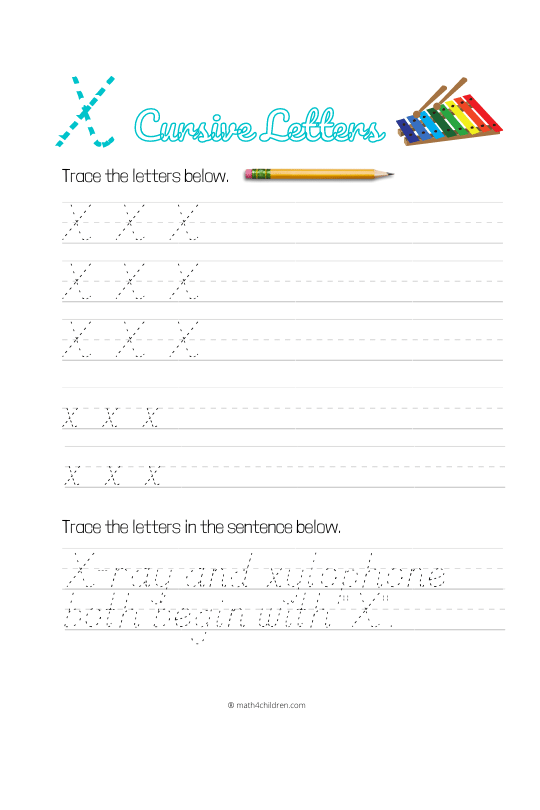![]()
Cursive X worksheet - Cursive handwriting letter X
Cursive X worksheet pdf
Download all A - Z cursive letters here >>
Let your little learners experience the joy of excellent handwriting by teaching them how to write the cursive letter “X.” It should come as no surprise that learning this refined version of the alphabet can be a tad difficult, but with some practice and encouragement, anyone can write well in cursive. You can make use of the best letter X cursive writing worksheets as convenient learning resources for your child’s next writing lessons at school or at home.
The cursive script can appear intimidating to first-time learners due to all of its twirls, flourishes and other nuances. All it takes to dispel this idea, however, is by guiding students in learning the script for themselves. It’s important to encourage students to keep writing even if they are frustrated with their progress, as they will gradually build the muscle memory to write in cursive effortlessly.
Let’s examine the composition of a model cursive letter “X” for a moment. A cursory glance can reveal that it is pretty straightforward to make – it can be made with two simple strokes. The first stroke starts at the upper left and moves downward. It usually begins and ends in small, wavy flourishes. The second stroke is simpler still – being a line that originates at the upper right and cuts the first stroke at a roughly perpendicular angle.
The lowercase “x” is practically a miniature version of its big brother, usually reaching only half of its height while retaining both of the flourishes at its ends.
X in Cursive
Cursive is a style of handwriting in which the letters are connected by flowing lines, rather than being written separately as in print handwriting. The word "cursive" comes from the Latin word "cursivus," which means "running." The use of cursive handwriting dates back to ancient civilizations, and it has evolved over time to become a popular writing style in many countries around the world. The letter "x" in cursive is written in a flowing, connected style, with the two diagonal lines of the letter joined together at the top and bottom. To write the letter "x" in cursive, start by making a small loop at the top of the letter, then draw a diagonal line down to the right, curving slightly to the left as you go. Next, bring the pen back up to the top of the loop and draw another diagonal line down to the left, curving slightly to the right as you go. Finally, join the two diagonal lines together at the bottom of the letter by drawing a small loop or curve. There are many different variations of cursive handwriting, and the specific way that the letter "x" is written may vary depending on the style of cursive being used. Some styles of cursive writing place more emphasis on flowing, continuous lines, while others have more distinct, separate letters. In general, cursive handwriting is considered to be more elegant and legible than print handwriting, and it is often used in formal documents and correspondence. It is also used in artistic and decorative contexts, such as calligraphy and handwriting analysis. Cursive handwriting is taught in schools in many countries, and it is often introduced in the early elementary grades as a way for students to develop fine motor skills and improve their handwriting. It is typically taught in conjunction with print handwriting, and students may be required to switch between the two styles depending on the context or the task at hand. Many people find that writing in cursive helps them to write more quickly and fluidly, and it can also be a relaxing and enjoyable activity. Some research has even suggested that cursive handwriting may have cognitive benefits, such as improving memory and concentration. In recent years, there has been some debate about the importance of teaching cursive handwriting in schools. With the increasing use of technology and the decline of handwritten documents, some argue that cursive handwriting is no longer a necessary skill. However, others argue that cursive handwriting is still an important part of our cultural and artistic heritage, and that it has a number of educational and personal benefits. Overall, the letter "x" in cursive is a flowing, connected letter that is written using diagonal lines and small loops or curves. It is a key part of the cursive alphabet, and it is an important element of the beautiful and expressive art of handwriting.

